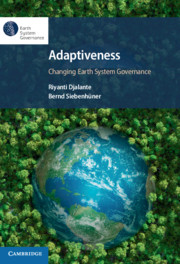Book contents
- Adaptiveness
- Adaptiveness
- Copyright page
- Contents
- Figures
- Tables
- Contributors
- Foreword
- Preface and Acknowledgements
- 1 On Adaptiveness
- 2 Synthesising and Identifying Emerging Issues in Adaptiveness Research within the Earth System Governance Framework (1998–2018)
- 3 Climate Change Adaptive Capacity Assessments
- 4 Assessing the Adaptive Capacity of Collaborative Governance Institutions
- 5 The Marine Debris Nexus
- 6 Synergies and Trade-Offs between Climate Change Adaptation and Mitigation across Multiple Scales of Governance
- 7 Lock-Ins in Climate Adaptation Governance
- 8 Governance and Climate Change Mitigation and Adaptation in Conflict-Affected Countries of Central Africa
- 9 Policy Tools and Capacities for Adaptiveness in US Public Land Management
- 10 Adaptiveness in Earth System Governance
- Index
- References
10 - Adaptiveness in Earth System Governance
Synthesis, Policy Relevance, and the Way Forward
Published online by Cambridge University Press: 22 June 2021
- Adaptiveness
- Adaptiveness
- Copyright page
- Contents
- Figures
- Tables
- Contributors
- Foreword
- Preface and Acknowledgements
- 1 On Adaptiveness
- 2 Synthesising and Identifying Emerging Issues in Adaptiveness Research within the Earth System Governance Framework (1998–2018)
- 3 Climate Change Adaptive Capacity Assessments
- 4 Assessing the Adaptive Capacity of Collaborative Governance Institutions
- 5 The Marine Debris Nexus
- 6 Synergies and Trade-Offs between Climate Change Adaptation and Mitigation across Multiple Scales of Governance
- 7 Lock-Ins in Climate Adaptation Governance
- 8 Governance and Climate Change Mitigation and Adaptation in Conflict-Affected Countries of Central Africa
- 9 Policy Tools and Capacities for Adaptiveness in US Public Land Management
- 10 Adaptiveness in Earth System Governance
- Index
- References
Summary
This chapter concludes the edited volume and its quest to harvest findings on the conceptual development of adaptiveness, as proposed by the Earth System Governance (ESG) Project. Adaptiveness is both a key attribute and goal of governance to anticipate, manage, and help steer complex societal, technological, and environmental changes towards more sustainable trajectories. Reiterating the main question of the book: How has adaptiveness, as an umbrella concept, been developed and applied in the context of earth system governance in the first decade after its inception, and what insights and practical solutions has it yielded? We have found that adaptiveness encompasses and relates to concepts including adaptive management and governance, adaptive capacity, vulnerability, resilience, robustness, and social learning. We elucidate how these concepts and further Harvesting Initiative findings relate to the 2018 Science and Implementation Plan of the ESG Project, in which adaptiveness is considered alongside the concept of reflexivity. We then look back on 10 years of progress to answer the so-called 'Utrecht Questions', exploring both the relevance of adaptiveness concepts in practice and their generalisability. Finally, we touch upon the 2009 ESG Science Plan and suggest how adaptiveness offers lessons for broader societal transformation and achieving global sustainability agendas.
- Type
- Chapter
- Information
- Adaptiveness: Changing Earth System Governance , pp. 188 - 200Publisher: Cambridge University PressPrint publication year: 2021
References
- 1
- Cited by

